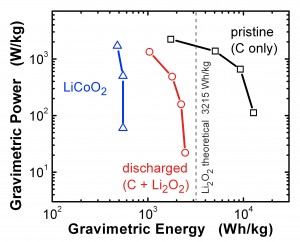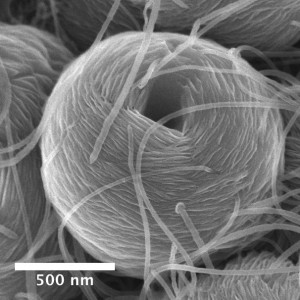Carbon Nanotube/Nanofiber Electrodes for High-energy Rechargeable Li-O2 Batteries
- Category: Energy, Nanotechnology
- Tags: carl thompson, robert mitchell
Recently, Li-O2 batteries have attracted much attention as potential next-generation alternatives to lithium-ion batteries for electric vehicle energy storage [1] . This interest is due to the extremely high theoretical energy density (~3200 Wh/kgLi2O2) available in the Li-O2 system. During discharge in a Li-O2 cell, Li+ reduces molecular O2 to form Li2O2in the void volume of a porous cathode [2] . Our recent work [3] has demonstrated that arrays of aligned carbon nanofiber electrodes with extremely high void volume (>90%) can deliver gravimetric energy densities ~5 times higher than state-of-the-art Li-ion batteries at comparable rates, as evident in Figure 1. The reported energy density approaches the theoretical energy density for Li2O2. The aligned carbon nanofiber structures from our previous study [3] were fabricated directly on a porous alumina substrate using chemical vapor deposition [4] [5] . Aligned nanofiber/nanotube structures also provide an ideal platform for performing ex-situ studies of the morphological evolution of Li2O2, and the shapes of Li2O2 discharge products have been shown to resemble toroids [2] [3] at low rates, as Figure 2 shows. Recent work has focused on the fabrication of tall (~500 µm- thick) freestanding vertically aligned carbon nanotube (VACNT) carpets as binder-free electrodes for the Li-O2 system. Additionally, we have performed extensive ex-situ SEM and TEM studies to investigate the morphological evolution of Li2O2 upon discharge and charge.
- Figure 1: Ragone plot comparing the performance of all-carbon nanofiber electrodes in Li-O2 cells to LiCoO2, a state of the art Li-ion cathode material.
- Figure 2: Li2O2 toroid particle formed in a Li-O2 cell upon discharging to 2.0 V vs. Li at low rates (100 mA/g).
- P. G. Bruce, S. A. Freunberger, L. J. Hardwick, and J. M. Tarascon, “Li-O(2) and Li-S batteries with high energy storage,” Nature Materials, vol. 11, pp. 19-29, Jan 2012. [↩]
- Y.-C. Lu, D. G. Kwabi, K. P. C. Yao, J. R. Harding, J. Zhou, L. Zuin, and Y. Shao-Horn, “The discharge rate capability of rechargeable Li–O2 batteries,” Energy & Environmental Science, vol. 4, pp. 2999-3007, 2011. [↩] [↩]
- R. R. Mitchell, B. M. Gallant, C. V. Thompson, and Y. Shao-Horn, “All-carbon-nanofiber electrodes for high-energy rechargeable Li–O2 batteries,” Energy & Environmental Science, vol. 4, p. 2952, 2011. [↩] [↩] [↩]
- G. D. Nessim, “Properties, synthesis, and growth mechanisms of carbon nanotubes with special focus on thermal chemical vapor deposition,” Nanoscale, vol. 2, p. 1306, 2010. [↩]
- G. D. Nessim, M. Seita, K. P. O’Brien, A. J. Hart, R. K. Bonaparte, R. R. Mitchell, and C. V. Thompson, “Low Temperature Synthesis of Vertically Aligned Carbon Nanotubes with Electrical Contact to Metallic Substrates Enabled by Thermal Decomposition of the Carbon Feedstock,” Nano Letters, vol. 9, pp. 3398-3405, 2009. [↩]

